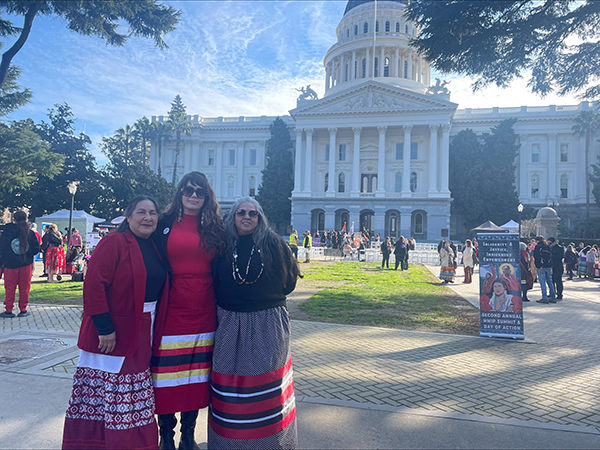Celebrating California’s Native American Communities
In celebration of Native American Heritage Month, we shine a spotlight on the California Interagency Council on Homelessness’ efforts to address homelessness in tribal communities.

L-R: Chairwoman Mary Norris of the Cahto Tribe at Laytonville, Vevila Blossoming Bear, Tribal Liaison for the California Interagency Council on Homelessness, and Tania Motas, Indian Child Welfare Act Coordinator of the Cahto Tribe at the 2024 Missing and Murdered Indigenous People’s Summit in Sacramento.
California Interagency Council on Homelessness
 “Our goal is to be in service to all tribal communities, whether it be federally recognized tribes, tribes who have not yet received recognition, and urban Native American communities. We do this through meaningful tribal consultation and culturally sensitive inclusion.”
“Our goal is to be in service to all tribal communities, whether it be federally recognized tribes, tribes who have not yet received recognition, and urban Native American communities. We do this through meaningful tribal consultation and culturally sensitive inclusion.”
Vevila Blossoming Bear, Tribal Liaison
California Interagency Council on Homelessness
In celebration of Native American Heritage Month, we shine a spotlight on the California Interagency Council on Homelessness’ (Cal ICH) efforts to address homelessness in tribal communities. Vevila Blossoming Bear is the Tribal Liaison of Cal ICH. A native of the Choctaw Nation, Vevila has over 20 years of experience working with tribes across the state.
She gets inspiration from her lived experience with homelessness and foster care. “My father was a civil rights activist,” explains Vevila. “I observed the impacts of harmful policies and programs in my community. My father was the type of person, if you see something, you do something, and I inherited that attitude from him.”
Creating change through the Tribal Homeless Housing and Prevention Program
Vevila developed and managed the Tribal Homeless Housing and Prevention Program (Tribal HHAP) from 2022-2024, the state’s first flexible homelessness funding program for California Federally Recognized Tribes. Tribal HHAP was developed and improved in partnership with tribal partners to ensure the program’s cultural responsiveness and accessibility for tribes with varying capacities and diverse needs. The program has been popular, seeing more demand for funding than is available. Additionally, the program has been cited as a best practice by tribal leaders. For details, visit the Tribal HHAP website.
“I am inspired by the Newsom Administration’s focus on truth and reconciliation with California Natives. This includes government accountability and building meaningful partnerships for change,” explains Vevila. “It’s an exciting time in tribal affairs. We can tell the truth about history and its impact and move forward in greater service to tribal communities.”
Listening to the needs of tribal communities
“In 2024, we held formal and informal tribal consultations with tribal leaders and communities throughout the state with a goal of uplifting tribal communities’ needs, concerns, and best practices into state programs and policies. Tribal communities have shared that they are in crisis. People are dying from despair. Tribal communities often feel forgotten and invisible. Even when included in government programs and policies, it’s often as an afterthought and without consultation.”
She emphasizes, “early and frequent tribal consultation is the first step toward change. This involves cultural responsiveness, respectful government to government relationships, inclusion, and the development of policies and programs that meet tribal community needs. Funding for tribal organizations and communities and recruiting Native American staff are key.”
Hope for the future
“I continue to be inspired by the resilience of Native American peoples and the strength, power, and love of the community leaders, elders, and others that I’ve had the opportunity to develop relationships with,” says Vevila. “Despite the horrific history the state has brought upon tribal communities, it continues to come to the table to build bridges of partnership and co-create solutions.” Vevila is proud to be part of that process, helping to create a brighter, more equitable future for California’s Native American communities.